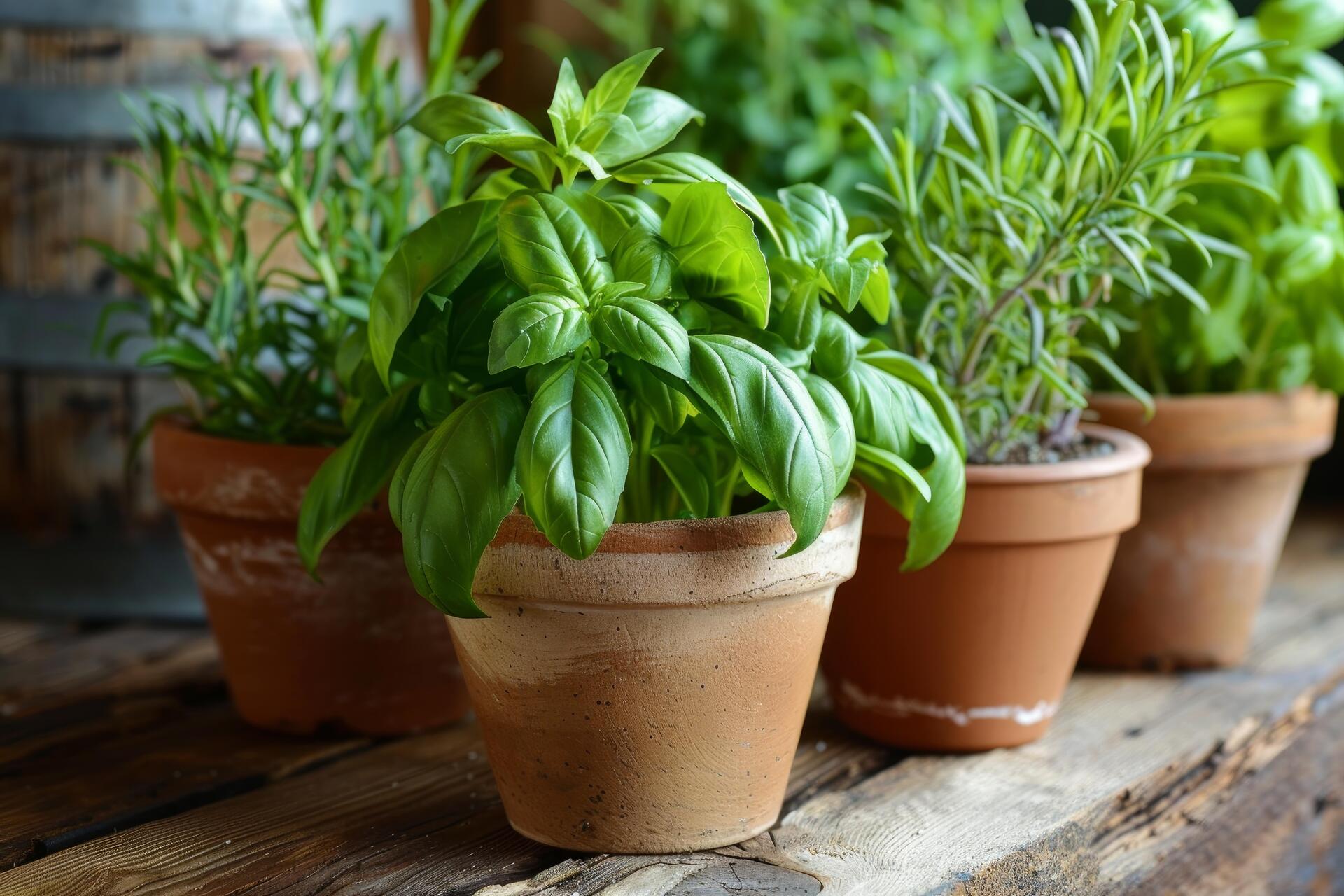
Growing a herb garden indoors is a great way to enjoy fresh herbs all year-round. Indoor plants, especially herbs, not only enhance your home’s aesthetics but also ensure you have access to fresh ingredients for those yummy scrumptious dishes.
In this blog, let’s explore how to grow your own indoor plants and set-up an indoor herb garden from scratch.
Different Kinds of Plants For Your Indoor Herb Garden
Selecting the right house plants is essential when you want to create an indoor herb garden. Here is a list of some popular indoor herbs that thrive wonderfully.
A List of House Plants for Your Indoor Herb Garden
- Basil–This is a must-have herb in every garden. Perfect for various cuisines, especially Italian, known for its mild peppery aroma, it grows nicely in sunny spots and can be plucked regularly to encourage constant growth.
- Parsley–Another wonderful house plant used for garnishing and adding flavour to dishes, Parsley is quite easy to grow indoors. It thrives in indirect light ( best when placed beside a sheer curtain, a shady tree outside the window, etc… to avoid direct sunlight).
- Mint– Ideal for use in teas and desserts, mint can grow vigorously and can take over a garden bed quickly. But when grown indoors in a pot, it helps control the spread and keeps it accessible.
- Thyme–A very versatile herb for cooking , thyme grows easily in a sunny location and well-drained soil. Regularly trimming it will keep it bushy and healthy.
- Rosemary -Fragrant and perfect for seasoning, rosemary thrives best with a lot of sunlight.. To regularly maintain shape it is best to prune it regularly.
- Oregano–A famous seasoning herb for Italian dishes, salads and soups,oregano grows well in pots under a sunny spot.
- Chives - With a mild onion flavour that is used to garnish dishes like salads or main meals, Chives easily grow in a pot and require minimal care. You can harvest it by snipping the leaves when needed.
- These house plants are the ideal options because they do not just add greenery and aroma to your indoor space but also provide healthy culinary benefits.
How to Plant Your House Plants?
Indoor plant care begins with proper planting techniques. Here’s a detailed guide to help you get started:
Soil Preparation
It is best to use a well-draining potting mix specifically designed for herbs. Usage of gardensoil may be too heavy for the indoor environment and may also harbour pests.Adding a little sand or perlite to the soil improves drainage.
Planting Seeds and Seedlings
1. Seeds: Fill the container or pot with potting mix, leaving about an inch at the top. Sprinkle the seeds over the potting mix evenly and cover it lightly with soil. Water gently to ensure you do not displace the seeds.
2. Seedlings:Dig a small hole in the soil, drop the seedling, and gently firm the soil around the roots. Water well to let it settle.
What Kind of Containers and Pots Are Best for Indoor Plants?
The next step in creating an indoor herb garden is the selection of the appropriate container. Some options are outlined here with additional hints for decorating indoor plants.
Types of Containers
1. Terracotta Pots: These varieties of pots are ideal for herbs like basil and parsley because they are by nature porous, so air and moisture easily pass through the system and provide much-needed circulation for the plants' roots.
2. Hanging Basket: Suits all those sprawling herbs like thyme and mint. They save you some space and create a magnificent view in your indoor garden.
3. Window Box: It grows various herbs in a small area. They are fitted on window sills and are easy to get sunlight.
4. Colourful/Uniquely Shaped Decorative Pots - Give decoration to the pots of your plants by opting for colourful pots or those that come in unique shapes. They will add a new dimension to your space.
Tips to Beautify Your Space
• Mix and Match - Various container types can be mixed and matched to create an interesting, hence beautiful, arrangement.
• Add Decorative Elements - Decorative stones, pebbles, or even seashells can top the soil, finishing off the look of your pots.
• Use Plant Stands: Elevate your pots with the help of plant stands to create a multilevel display and give depth and dimension to your house garden.
5 Key Essentials of Indoor Plant Care
Proper care will keep your herbs healthy and green. Here are four of those key elements:
1. Sunlight
Most herbs require about 6-8 hours of sunlight. If there's a south-facing window, place them there, otherwise use grow lights since most homes are light-challenged. Rotate the pots regularly so they have evenly distributed light.
Keep the soil moist but not waterlogged. Most herbs prefer an almost dry medium between waterings. Do this with a narrow spout watering can so you won't overwater and wet leaves.
2. Pest Control
Monitor for aphids, spider mites, whiteflies, etc. The application of natural insecticides or other homemade cures prevents further infestation.
3. Harvesting and Pruning
Harvest your herbs regularly. This will help their growth to avoid becoming leggy. Take the leaves and stems, but cut them above the leaf node using sharp scissors.
4. Replacing and Replanting
Certain herbs grow fast, examples are basil and parsley, and may be replanted often. Be observant of how they do well and stand ready to plant new seeds or get seedlings as needed.
The Best Place to Keep House Plants
The best place for keeping your house plants makes a lot of difference in the growth of your plants. Here are some unique ideas to help you create the perfect spots for your indoor herb garden:
Kitchen Windowsill
The kitchen windowsill is convenient and has free sunlight; being near the herbs while cooking allows you to easily clip fresh leaves as needed.
Living Room
Plant stands can be arranged to form a green nook in your living area. Offers an ideal growth habitat, and it gives décor a green vibe.
Balcony (Open or Closed)
It is the perfect place for a herb garden. It mostly receives good light. Use the rail planters, or you can put up a growing system against the walls to make maximum use of the small space on the balcony.
How to Maintain and Care for Your Indoor Garden?
Maintaining your indoor garden requires some regular tasks to keep your plants healthy and productive. This includes:
• Watering: Check the moisture of the soil regularly and water accordingly. However, one must be careful not to water excessively.
• Fertilizing: A balanced, water-soluble fertilizer once in a few weeks will supply necessary nutrients.
• Pest Monitoring: Keep a regular check on the plants to detect any signs of pests or diseases and take timely action.
• Pruning - This should be done regularly to keep herbs bushy and full and prevent them from becoming leggy.
• Cleaning - Dead or turning yellow leaves can make plants look unsightly and, more importantly, sickly. Cleaning is therefore necessary to maintain the health and appearance of plants.
Tools You May Need to Grow and Maintain Indoor Flowering Plants
Having the right tools makes indoor gardening easier and more efficient. The following are some of the essentials:
• Watering Can –Narrow spout watering can to avoid making a mess.
• Pruning Shears: Clean cuts need to be made for healthy plants.
• Plant Labels: Identify which herb is which and watch their growth.
• Small Trowel: Planting seeds or seedlings is going to be a breeze.
• Spray Bottle: Keep misting those plants and that humidity in check.
Where to Buy Indoor Plants Online?
For an excellent variety of indoor plants, visit PlantArk. It's the easiest way to shop for indoor plants online, with everything imaginable to make your gardening dreams a reality. You'll find top-quality plants and seedlings, plus all you'll need to get started and tend to your indoor herb garden.
How Do You Make Money Selling Your Indoor Plants?
If you have a lush indoor garden and you want to sell some of your herbs, use PlantArk as a marketplace since it's an excellent channel to reach customers and earn from the hobby. Here are a few tips to help you get started:
• List your plants with detailed information, clear photos, and descriptions.
• Set competitive prices by studying the market prices for herbs.
• Promote Your Listings: Share your listings with social media and other online channels to attract more buyers.
• Good Customer Service: Reply to all inquiries and ship on time to create a positive reputation.
Follow these steps and tips to maintain an indoor herb garden, enjoy fresh herbs throughout the year, and even sell some of your plants online to earn extra money.
Frequently Asked Questions
Which Is the Best Potting Mix for Indoor Plants?
Normally, a well-draining potting mix that can also hold some moisture to hydrate the roots is best for indoor plants, especially herbs. Look for mixes labelled specifically 'indoor plants' or 'herbs'; these will mostly contain a mix of peat moss, vermiculite, and perlite. These ingredients will ensure good aeration and drainage, thus avoiding root rot and promoting healthy growth. You can also add some compost in order to enrich the soil with nutrients. Garden soil should not be considered since it is usually way too dense for any kind of indoor plants and might contain pests or diseases.
Which is the Cheapest Way to Have a Herb Garden?
Want an herb garden on a budget? It all starts with seeds, not seedlings or mature plants. Seeds are relatively very cheap and offer so much more in terms of herbs options. Here is a basic, low-cost solution:
Buy Seed Packets — Pick different herbs you use in your daily cooking.
Reuse Containers: Use containers like yogurt cups, egg cartons, or tin cans. Remember to poke drainage holes in the bottom.
Home-Made Potting Mix: Combine equal parts of peat moss, compost, and perlite for an easy way out of the potting mix.
Do-It-Yourself Plant Labels: Use Popsicle sticks or old plastic spoons for labelling.
Get a healthy herb garden growing without spending a fortune by starting from seeds and using such reused materials.
Which is the Fastest Growing Herb?
Basically, the fastest herb to grow is the basil plant. Basil seeds can germinate in 5-7 days, and you may start harvesting its leaves in as short as 3-4 weeks. If under perfect conditions, it grows fast when exposed to enough direct sunlight and adequate watering.
Do Herbs Grow Better in Pots or in the Ground?
Herbs can be grown in pots as well as in the ground, but there are certain definite advantages to pot growth, especially for indoor growing:
Successively Controlled Environment: Pots provide better control over soil quality, amount of moisture retained, and amount of light falling on them.
Mobility—Potted herbs can be moved easily towards sun rays or may be moved into a place that protects the plants from stormy weather.
Pest Management—It does reduce the possibility of pests and diseases, which are more prevalent in ground-soil cultivation.
Space Efficiency—Pots come in handy in small spaces like apartments where garden beds aren't an option.
Ready to get started on your indoor herb garden? Explore a large selection of quality indoor plants, seeds, and related gardening supplies through PlantArk. With easy online shopping and expert advice, you can quickly find all you need to raise a beautiful, lush indoor herb garden. Happy gardening!


